Shanghai
This is part 5 in a series - for the others see Beijing Day 1, Day 2, Day 3, or Days 4-5.
We arrived in Shanghai via train at 7:30 in the morning. We weren't quite sure what to do with our bags at that point so we just took a cab to our hotel, hoping that they would allow us to store them until check-in time. Luckily, they had the room already available and we were able to check in at 8:00 AM. There didn't even seem to be any surcharge or fee.
The hotel was pretty centrally located in downtown Shanghai, so we were able to walk out and see pretty good views of the Huangpu riverside:
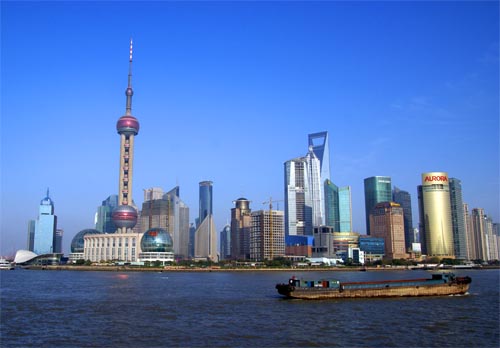
On the east side of the river is Pudong, which is the ultra-modern business/financial district of the city. Most of it has been constructed within the last 15 years. On the west side is "The Bund", which is the old part of the city:
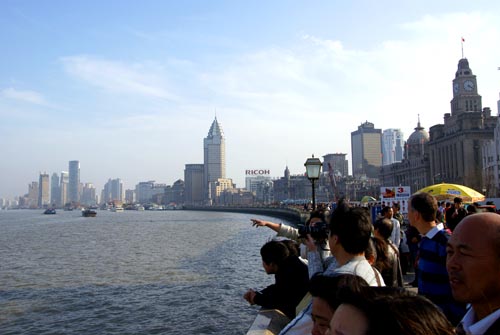
Many of the buildings along the waterfront here were built in the British/French colonial days of the 19th Century. This gives Shanghai a weird sort of architectural vibe - it's split between the new and the old, yet neither is traditionally "Chinese" in character.
The city has a distinctly different feel than Beijing. It's very Westernized and there's relatively little in the way of Chinese cultural history behind it. Before the Opium Wars, Shanghai was just a small port village at the mouth of the Yangtze River. After the wars it was conceded to the foreign powers, who built it into a big city. Even though it was eventually taken over by the communists, there are still large numbers of foreigners living in the city, often living in their own little isolated enclaves, surrounded by millions of Chinese people.
On the first day we walked around nearby the hotel. The city extends farther than the eye can see, and so does the space-age sort of architecture:

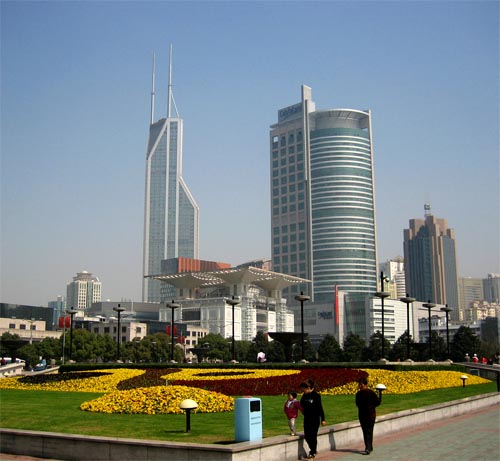
I visited the Shanghai Museum, which is supposedly one of the best in China. It did have a large collection of ancient Chinese artifacts, but the variety of displays was somewhat disappointing (after you've seen a few porcelain bowls, another 200 look pretty similar). It didn't really compare to visiting the Louvre or the Met - I'm not sure whether this was because all of the interesting works of art were plundered by foreigners, or because historical Asian culture just didn't place as much emphasis on venerating the Artist as an individual (I wouldn't be able to name Chinese equivalents of Van Gogh, Michelangelo, etc). Or maybe the true explanation is something my insensitive Western mind is unable to grasp - it was sort of an interesting question to ponder.
On the second day we visited the Yu Gardens, which is a nice little oasis of green in the middle of the city:
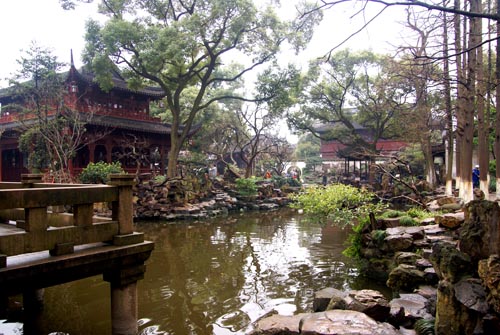
Unfortunately it turned out that the gardens were built for a rich landowner "in the style of" a traditional Chinese garden, so they lost a few authenticity points there. Still, there were some interesting sights, like the Koi pond:

Next to the gardens was a bazaar with all kinds of shops selling various things:
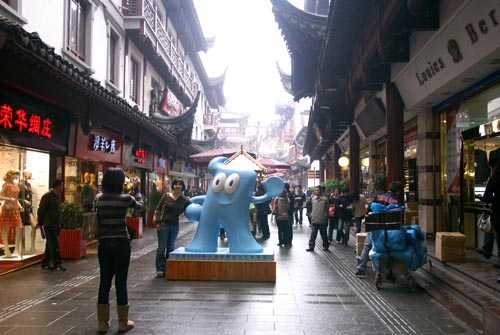
The blue character in the picture above is the mascot for the Shanghai World Expo 2010. He was plastered all over the city, half of which was under (re-)construction in preparation. I imagine that Beijing was similar a couple years ago in preparation for the 2008 Olympics. It's clear that the Chinese government wants the Expo to do for Shanghai what the Olympics did for Beijing - i.e. be a sort of international coming-out party. Even the propaganda boats on the river got in on Expo-fever:
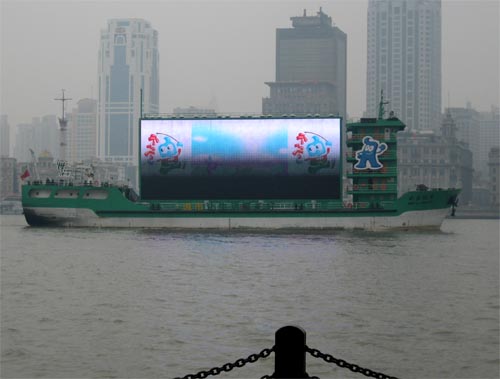
On the third day I went to explore Pudong and the other side of the river. I wanted to visit the Shanghai World Financial Center (the building with the big hole in the top) and see the city from the "tallest observation deck in the world," but unfortunately it was overcast and foggy that day so you couldn't see very far:
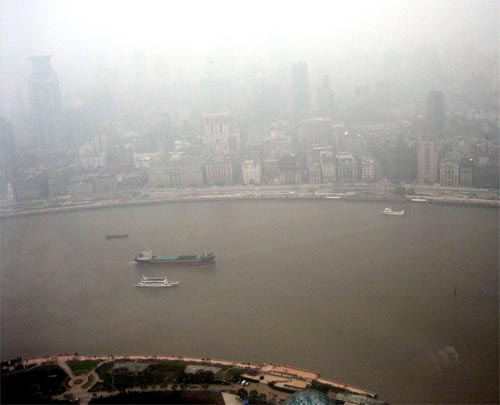
View of the Bund from Pudong
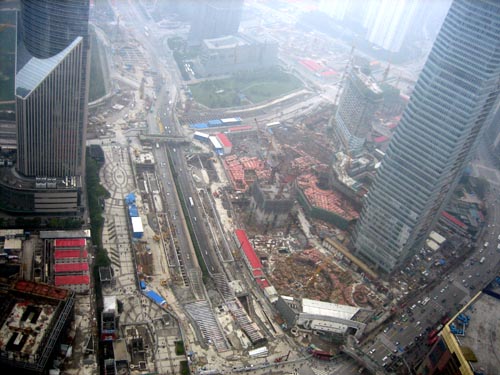
Pudong could be summed up as "under construction"
Other than the skyscrapers, Pudong is mostly a financial & business district, so there wasn't a whole lot else to see.
That evening we went to visit our former co-worker Roland who was in Shanghai working for Microsoft. Unfortunately we only had his address in English, which didn't work too well for the cab drivers. We tried to pronounce the name of the street for one driver, but he got angry and kicked us out of the cab - presumably he was saying "you can't just give me the name of the street, it's very long so I wouldn't know where to stop!" With a second cab, we got the hotel porter to read off the address in Chinese and the driver agreed to try to find it. We finally did make it and our friend took us to a fancy Australian restaurant (yes, we ate Australian food, with our German friend, in China - wait, what?). Unfortunately they were out of ostrich, so he had to settle for an emu steak. We also had crocodile appetizers:
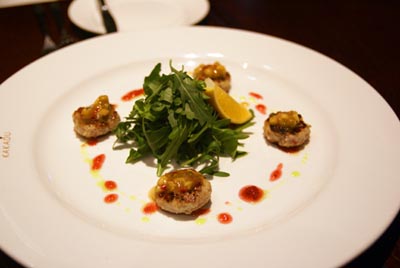
Crocodile sort of tastes like chicken.
On the fourth day in Shanghai we had sort of run out of things to see (more because we failed to fully research ahead of time, rather than because Shanghai did not have enough sites to see). We took the advice of a couple of different people and took a train ride to Hangzhou, a "small" city (only 6 million people!) about an hour and a half away by train. Apparently it's widely revered for its great natural beauty, which probably wouldn't be the first thing you'd say about Shanghai or Beijing. The city's West Lake is the original lake which the Summer Palace in Beijing was modeled after.
Alas, it was also raining and overcast on that day too, but we were able to get a few pictures:

The lake has several islands and pedestrian causeways
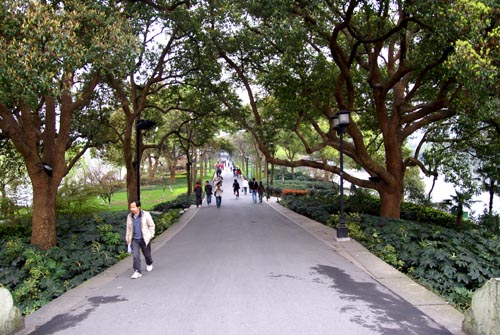

Overall Hangzhou was a nice side trip for the day - it would have been even more so had it not been raining.
On the fifth day we flew off to Tokyo. While in China we had accumulated so much stuff that it wouldn't all fit in our original bags on the flight, so we needed to buy an additional suitcase. We went to the shopping district on Nanjing Road, which is where all the fake knock-off merchandise can be found. Pretty much any piece of expensive designer clothing or apparel can be found as a knock-off in China. There are apparently even several different quality levels of fake goods, ranging from dirt-cheap knock-offs that wouldn't fool even a child, all the way up through really good-looking fakes that would be hard to tell apart from the real things unless you had expert knowledge. For our luggage, we only needed something that functioned, so we picked up this "Samsonmte" suitcase for $14:
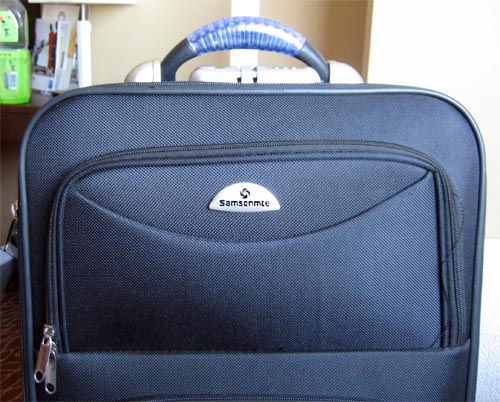
It's the most cheaply-made suitcase I have ever seen - the pockets on the side aren't even real pockets, they just open up into the main compartment. Still, it did the job.
Tomorrow's post: Tokyo!


